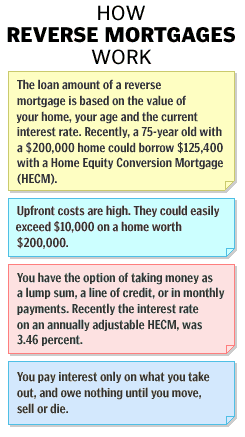BEND, Ore. (CNN/Money) – "House rich, cash poor" is a dilemma more older Americans are finding themselves in these days, particularly if they are footing the bill for long-term care in or outside of the home.

Though rising home values have boosted the net worth of seniors -- 80 percent of whom own their own home -- they do little to improve their day-to-day finances.
To address the problem, the National Council on Aging (NCOA), a nonprofit advocacy group, is developing a "Use Your Home to Stay at Home" program to promote the use of reverse mortgages as a way to pay for long-term care.
The concept is simple: With a regular (forward) mortgage you put more equity into the house when you make your payments. With a reverse, you pull equity out of the house.
"People are sitting on a lot of equity," said Scott Parkin, a spokesman for the NCOA, which estimates that, collectively, seniors have more than $1.8 trillion in home equity. "What we're saying is you can use this money to prevent going on Medicaid."
Seniors who don't have long-term insurance or can't afford to pay costs out of pocket often qualify for Medicaid, which foots the bill for certain long-term care expenses. But Medicaid generally only covers care at nursing-home facilities.
"There is a great opportunity here for people to stay out of nursing homes and get the care they want in the place they want, which is normally at home," Parkin added.
There is, of course, also an opportunity to reduce Medicaid's responsibility for long-term care costs, which are expected to double in the next 30 years. Among the panel of experts working on the program are representatives from the National Governors Association and the National Conference on State Legislatures.
Last month, the program received $295,000 in grants from the Centers for Medicare & Medicaid Services (CMS), the federal agency that oversees the programs.
"It looks like the government is trying to reduce its costs," said Steve Weisman, an estate planning lawyer in Cambridge, Mass., and author of "A Guide to Elder Planning: Everything You Need to Know to Protect Yourself Legally and Financially."
While reverse mortgages make sense in some cases, they also carry hefty up-front costs and can quickly eat into home equity. There is a risk, said Weisman, that this niche product will be "oversold as being too good for too many people."
The skinny on reverse mortgages
Representing just a fraction of all loans, reverse mortgages allow homeowners to borrow money from the equity in their home either in a lump sum, as a line of credit or through monthly payouts.
If you opt for the line of credit, you pay interest only on what you actually use. Recently, the interest on the Home Equity Conversion Mortgage (HECM), the most popular such loan, was 3.46 percent.
Unlike other kinds of home loans, however, a reverse mortgage doesn't require taking on additional monthly payments. Nothing is owed until the homeowner sells, moves or dies.
You don't have to own your home outright to do a reverse mortgage. "If you owe money on the house you can use part of your reverse mortgage to pay off your current debt," said Ken Scholen of AARP (the group formerly known as the American Association of Retired Persons).
You do, however, need to be at least 62 years old.
The amount you'll receive from a reverse mortgage depends primarily on your age, the value of your home and current interest rates. Recently, a 75-year-old with a $200,000 home could borrow $125,400 with an HECM.
The price of reversing
For all of their convenience, a reverse mortgage still may not be the best solution for tapping your home's equity.
"If you're only going to be in your home a couple of years, the cost of this loan is very, very high," Scholen said, explaining that initial costs for a $200,000 home easily could add up to $10,000.
Up-front costs for the HECM include:
- Origination fee equal to $2,000 or 2 percent of the loan limit, whichever is greater.
- Mortgage insurance premium equal to 2 percent of the maximum claim amount or home value, whichever is less. (This up-front insurance is waived only if the all of the loan is used to pay for long-term care insurance.) There also is an ongoing annual premium equal to 0.5 percent of the loan balance.
- Other closing costs, such as title insurance, and fees for appraisal, credit reporting, escrow, document preparation and recording. Depending on the size of the loan, these costs could exceed $2,000.
- Servicing set-aside fee. This is money taken out up-front to the projected monthly costs of servicing a loan. According to the National Reverse Mortgage Lenders Association, this fee can amount to several thousand dollars.
The other major problem with reverse mortgages, Weisman said, is that because you don't pay down your debt until you sell, move or die, the interest compounds quite a bit over time.
Mandatory mortgage insurance ensures that you (or your heirs) don't end up owing more than the house is worth. But it's entirely possible to drain all or most of your home's equity.
"One thing I always encourage people to do is seriously consider the alternative of selling and moving before doing a reverse mortgage," Scholen said.
"Some people decide that staying in their home is more valuable than they had even realized," he added. "Others decide it's better to just move."

|

